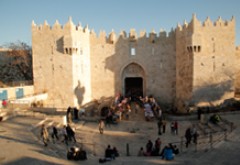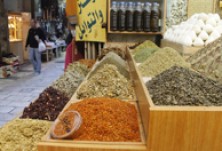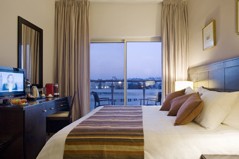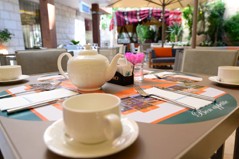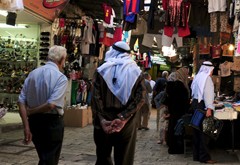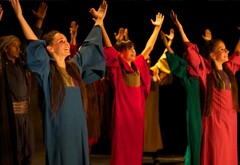St. Anne’s Church, or what was once a Shafi’i Jurisprudence school known as al-Salahiyya School, is located twenty meters west of Bab al-Asbat (Lions Gate), on the northern side of al-Mujahideen Street. The site is open all week except Sunday, but closes from midday to 2 pm daily. An entry fee is charged, with local residents exempt. After entering, a rich garden meets visitors, with a statue of Father Lavigerie, who established the order of White Fathers. The garden was built on the site of a nunnery established during the Franks era.
The Serapius Asclepius Order
This site has a vibrant history from the late Greek era until today. Initially, it comprised a large pool of two troughs to collect water, the northern one measuring 40 x 40 meters and the southern measuring 65 x 50 meters, separated by a 60 meter long, 6 meter wide dam. Sick people started to congregate around the pools, seeking recovery by the pagan god of medicine, Serapius Asclepius. It is believed that Jesus Christ witnessed the remains of these practices at the site and performed a miracle of curing a sick man, proclaiming that the real cure comes from God.
Building Byzantine and Franks Churches
After this miracle, and based on eastern traditions, which believe that St. Anne gave birth to Virgin Mary, Mother of Jesus Christ, in a cave near this pool, the site became a destination for Christian pilgrims. They started visiting surrounding caves, leading, during the Byzantine era, to building a huge basilica over the pool, extending to the pagan healing site. This basilica, however, was demolished during the Persian conquest, and was rebuilt by Modestus the Monk. During the Franks era, a small church was built on the site of the Byzantine basilica to commemorate Christ’s miracle of healing the paralyzed man, and another, larger church was built over the cave where Virgin Mary is thought to have been born. This church is still standing, maintaining its foundations and Franks style architecture, and is among the most beautiful churches in Palestine.
Shafi’i Jurisprudence School
After evicting the Franks from Jerusalem, this church was turned in 1192 AD (588 H) into a school of Islamic jurisprudence and known as al-Salahiyya, after its patron Sultan Salah al-Din al-Ayyubi (Saladin). It was among the most famous and important schools of Jerusalem since its establishment and until 1856 AD, when Ottoman Sultan Abdul Majid decided to offer it as a gift to French Emperor Napoleon III, as a symbol of the Ottoman Empire’s appreciation of the French position in the Crimean war.
This school had the best and most educated scholars, and its property was considered the richest among all schools. It had a pioneering role in enhancing intellectual and jurisprudence life in Jerusalem.
The Franks basilica is located north of the garden, and is accessible through a gate south of the main middle gate of the church’s northern side. Before entering the church, one can see the only remaining indication that the building was used as a Shafi’i jurisprudence school, namely, a plaque of 144 x 50 centimeters with an embossed inscription in Ayyubid calligraphy script, comprising five lines, as follows:
In the Name of God the Merciful, most Compassionate. The Grace you have is a gift from Allah (God). Our master al-malik al-Nasir Salah al-Din wa al-Doniya, Sultan of Islam and Muslims, Abi al-Muzaffar Yousuf Ibn Ayyub Ibn Shadi, the reviver of the state of amir al-muminin, may God elevate his followers and grant him the good of life and the afterlife, has endowed this blessed school for scholars who adheres to Imam Abi Abdullah Muhammad Ibn Idriss Al-Shafi’I, may God bless him, in the year 588H.
Basilica’s Interior
The basilica’s interior comprises a rectangular hall with three aisles, the middle of which is the widest. The floor is covered with marble and the ceiling is cross-vaulted, supported by Gothic pillars resting on elongated stone foundations. The nave’s ceiling is covered by a semi-circular dome, supported by huge pillars. The basilica has a relatively unadorned interior, a clear influence of St. Bendictus. The little adornment is limited firstly to the altar area, where scenes designed by French sculptor Phillipe Kaeplin in 1954 depict the Nativity on the left, the Descent from the Cross in the middle, and the Annunciation on the right, as well as Mary holding the body of Jesus after it was taken down from the Cross, and secondly, to the carved ornaments of some columnar crowns, where a bull’s head can be seen: a symbol of St. Luke, and a human bust, symbolizing St. Matthew, as well as some incomplete column crowns.
Basilica’s Grotto
St. Anne’s Basilica comprises a natural grotto, presently covered with a modern, stone dome in front of which is a small altar. The grotto is allegedly the birthplace of Virgin Mary, Christ’s mother, according to the Eastern Church. Hence, the Franks built the Basilica we see today. Across from this enclosure is another one, which houses the Birth of Mary icon.
Archaeological Excavations
It is useful to review the illustrations and charts which relate the archaeological artifacts to their buildings and timelines. There are colored, brief signs which help understand and trace the archaeological remains.
Excavations started in 1871 under the supervision of Architect Marcel Mauss and continued for a number of years with the participation and supervision of the order of White Fathers, until they were completed in 1957. The excavations revealed the two-basin pool, separation dam, Roman wells, remains of the healing temple and of a Byzantine church, the small Franks church’s nave, as well as a number of caves and grottos, some of which were used to store water. A number of mosaic floors, some of which date to the Umayyad period, were also found. Pottery chards and coins discovered on the site helped specify its age.

